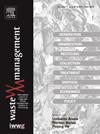Comparative analysis of metal oxide nanoparticle accumulation in landfill gas engine combustion chambers: Insights from three sites
IF 7.1
2区 环境科学与生态学
Q1 ENGINEERING, ENVIRONMENTAL
引用次数: 0
Abstract
Combustion chamber deposits adversely affect the operating performance of gas engines. In this study, the elemental composition of deposit samples collected from the inner surface of combustion chambers in gas engines across three different facilities was examined using various methods. The proportional changes in metal oxides along the internal cross-sectional surfaces of the deposits were examined to depict the deposit formation process from beginning to end. Additionally, the study investigated the identification of metals accumulated in the engine oil, their contribution to deposit formation, and the accumulation mechanisms of metal oxide nanoparticles on the engine’s interior metal surfaces. The main elements identified in the deposits from the Odayeri and Kömürcüoda facilities were Si, S, and Ca, whereas deposits from the Dilovası facility contained Si and Sb. These major elements, identified by SEM-EDS, were confirmed through XRF analysis. XRD analysis further confirmed the presence of Ca and S as CaSO4 crystals in the deposits. Ca originates from additives used to increase the total base number of engine oil and control the corrosive effects of landfill gas. It has been determined that silicon accumulates in engine oil over time. An important finding is that metal oxides in the combustion chamber primarily accumulate through impaction, sticking, and thermophoresis mechanisms.
垃圾填埋场气体发动机燃烧室中金属氧化物纳米粒子积累的比较分析:来自三个地点的启示。
燃烧室沉积物会对燃气发动机的运行性能产生不利影响。在这项研究中,我们使用各种方法检测了从三个不同设备的燃气发动机燃烧室内表面收集的沉积物样本的元素组成。研究了沉积物内部横截面上金属氧化物的比例变化,以描述沉积物自始至终的形成过程。此外,该研究还调查了发动机油中积累的金属的识别、它们对沉积物形成的作用以及金属氧化物纳米颗粒在发动机内部金属表面的积累机制。在 Odayeri 和 Kömürcüoda 工厂的沉积物中发现的主要元素为 Si、S 和 Ca,而在 Dilovası 工厂的沉积物中则含有 Si 和 Sb。通过扫描电子显微镜-电子显微镜 (SEM-EDS) 确定的这些主要元素通过 XRF 分析得到了确认。XRD 分析进一步证实,矿床中的 Ca 和 S 以 CaSO4 晶体的形式存在。钙来自于用于增加机油总碱值和控制垃圾填埋气腐蚀性的添加剂。已确定硅会随着时间的推移在发动机油中累积。一个重要的发现是,燃烧室中的金属氧化物主要是通过撞击、粘附和热泳机制积累起来的。
本文章由计算机程序翻译,如有差异,请以英文原文为准。
求助全文
约1分钟内获得全文
求助全文
来源期刊

Waste management
环境科学-工程:环境
CiteScore
15.60
自引率
6.20%
发文量
492
审稿时长
39 days
期刊介绍:
Waste Management is devoted to the presentation and discussion of information on solid wastes,it covers the entire lifecycle of solid. wastes.
Scope:
Addresses solid wastes in both industrialized and economically developing countries
Covers various types of solid wastes, including:
Municipal (e.g., residential, institutional, commercial, light industrial)
Agricultural
Special (e.g., C and D, healthcare, household hazardous wastes, sewage sludge)
 求助内容:
求助内容: 应助结果提醒方式:
应助结果提醒方式:


